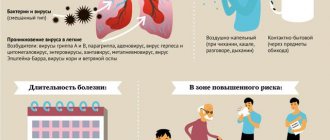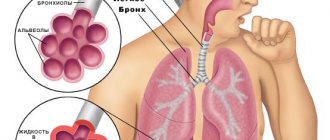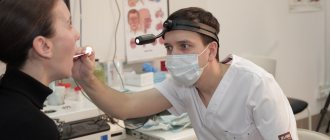Pneumonia can be suspected by its characteristic symptoms - high body temperature combined with a severe cough. However, this is not always the case. In some cases, the temperature does not rise, but the person continues to cough. This can confuse the patient and he puts off visiting the doctor. As a result, valuable time is lost. When contacting the Yusupov Hospital, the patient is immediately prescribed an examination, thanks to which it is possible to accurately diagnose and begin treatment on time.
Causes of pneumonia
Almost always, an inflammatory reaction in the lung tissue is caused by an infection. Pneumonia can be caused by many microorganisms - bacteria (most often), viruses, fungi and even some types of protozoa. In the vast majority of cases, the cause of pneumonia is:
- streptococcus pneumoniae - pneumococcus;
- chlamydia;
- haemophilus influenzae - hemophilus influenzae;
- respiratory syncytial virus is the most common cause of viral pneumonia
- other types of streptococci;
- staphylococci;
- mycoplasma.
Sometimes pneumonia can also be non-infectious and be caused by:
- toxic lesions of lung tissue;
- allergic reactions;
- autoimmune diseases;
- exposure to extreme temperatures;
- penetrating radiation (cancer patients undergoing radiation therapy to the lungs).
Risk factors
Predisposing factors for the occurrence of inflammation in the lung tissue are:
- chronic diseases of the endocrine, cardiovascular and respiratory systems;
- disturbances in the functioning of the immune system;
- bad habits (primarily smoking);
- malformations of the respiratory system;
- sedentary lifestyle.
Severe cases of the disease occur especially often in older people over the age of 65. Pneumonia is also extremely dangerous in newborns and children of primary school age. It is these categories of patients that account for the vast majority of deaths.
Types of pneumonia
According to the prevalence of the process, pneumonia can be:
- focal, affecting only a small area;
- segmental, spreading to one or more segments of the lung;
- lobar, occupying the entire lobe of the lung;
- total, with damage to the entire lung.
The disease is classified according to its causes:
- bacterial pneumonia;
- viral pneumonia;
- mycopneumonia;
- mixed types, in which massive infection with various microorganisms leads to inflammation of the lung tissue.
In addition, there are unilateral (affecting one lung) and bilateral pneumonia (affecting both lungs). Based on the duration of the course, there are acute forms, lasting up to 3 weeks, and subacute forms, lasting from 3 to 6 weeks. Finally, depending on the severity of symptoms, pneumonia can be mild, moderate, or severe, and may or may not have complications (primarily heart and/or respiratory failure).
Diagnostics
If you suspect latent pneumonia, you should undergo a comprehensive diagnosis. The disease can be identified by studying the gas composition of the blood, analyzing lavage water from the bronchi, or examining mucus obtained during bronchoscopy.
Tests that are widely used but do not allow for a correct diagnosis:
- Donating blood to count the number of leukocytes. The analysis is not informative due to the reduced immune status.
- Sputum analysis. The patient is simply unable to cough it up.
- X-rays of light. The source of inflammation is simply not visible during the study.
Bronchoscopy is one of the priority examination methods to detect pneumonia without fever. The patient is seated on a chair with a straight back. The airways should be as relaxed as possible. A device equipped with a camera and a light source is inserted through the mouth or nose. With its help, the doctor examines the condition of the respiratory organs from the inside, and also collects material for further study. The procedure is performed under local anesthesia.
Signs of pneumonia
The standard clinical picture of pneumonia is characterized by symptoms:
- Sudden onset.
- A sharp rise in body temperature above 38 0C.
- Rapid onset of cough with sputum production.
This is how almost all bacterial and viral pneumonias begin, including the most common variants caused by pneumococcus. As the disease progresses, the symptoms include shortness of breath and painful, often stabbing, sensations in the chest. Such symptoms can persist in the patient for up to 2 weeks.
The modern clinical picture of community-acquired pneumonia can vary widely and be “erased” due to the uncontrolled use of antibacterial drugs. Has symptoms of respiratory infections:
- your health will deteriorate over several days;
- dry cough with virtually no phlegm;
- headache;
- increased weakness and fatigue;
- muscle soreness;
- pain and sore throat.
Where to go if you have a burning sensation in your chest?
Are you a resident or guest of the capital and are you faced with a similar problem? Contact CELT. Our clinic is multidisciplinary and has departments of various specializations. You can make an appointment with a cardiologist, therapist, neurologist or gastroenterologist and get the help you need.
Our diagnostic department offers ample opportunities for correct diagnosis and identification of pathological conditions in the initial stages of development. Our staff is staffed with highly qualified specialists: doctors of the highest category, candidates and doctors of science with decades of medical practice behind them.
You can find out our prices by going to the “Services and Prices” tab in this section. To avoid misunderstandings, we recommend that you check the numbers with our operators by calling the number.
Expert opinion
More than 1 million cases of pneumonia are diagnosed annually on our planet.
Moreover, almost 8.5% of them are fatal. Of course, the vast majority of such adverse outcomes occur in groups at risk for pneumonia: children under 5 years of age and elderly people over 65 years of age. However, even if you are young and healthy, neglecting pneumonia is extremely dangerous. At the first manifestations of this disease, you should immediately consult a doctor and under no circumstances self-medicate. Pulmonologists at SM-Clinic will make a diagnosis as quickly as possible, determine what exactly caused pneumonia and prescribe the necessary therapy. It will include modern highly effective drugs and techniques, and will be built in accordance with the clinical recommendations of the Russian Respiratory Society and the Interregional Association for Clinical Microbiology and Antimicrobial Chemotherapy, approved by the Ministry of Health of the Russian Federation and WHO recommendations.
Savina Maria Yuryevna, pulmonologist at SM-Clinic in Ryazan
Treatment of pneumonia
The basis of treatment for pneumonia are drugs that act directly on the cause of the disease:
- antibiotics for bacterial infections;
- antiviral drugs for viral infection;
- antifungal agents for fungal invasion, etc.
The total duration of treatment of bacterial pneumonia with antibiotics averages from 7 to 10 days. For infection with mycoplasma or chlamydia, the course of treatment lasts at least 14 days. If pneumonia was caused by rarer pathogens (enterobacteria, legionella, etc.), then therapy can last 21 days or more. The criteria for stopping antibacterial treatment of pneumonia in adults are maintaining normal body temperature for 2-3 days, the absence of inflammatory symptoms and normalization of blood counts.
Also, for pneumonia, therapy is prescribed to alleviate the symptoms of the disease:
- drugs that dilate the bronchi and thin the sputum to clear the airways;
- corticosteroids;
- saline solutions to maintain water-salt balance;
- oxygen inhalation for respiratory failure;
- physiotherapy at the final stages of the disease (UV irradiation, vibration massage, physical therapy, etc.).
Symptoms
The first manifestations of latent pneumonia are significant fatigue during physical activity, pale skin, attacks of rapid heartbeat, and difficulty breathing. Asymptomatic pneumonia can be determined by the presence of subtle manifestations:
- progressive decrease in body weight;
- shortness of breath with minor physical exertion;
- sickly pallor of the face, combined with red spots on the cheeks;
- whistling sounds when breathing in or out.
In the initial stage of asymptomatic pneumonia in children, parents and pediatricians pay attention to the child’s lethargy and decreased activity, restless sleep, loss of appetite, increased moodiness, and intense sweating. In the area of the nasolabial triangle, the skin may have a blue tint.
Hospital-acquired pneumonia is quite often asymptomatic. A sudden increase in body temperature, a deterioration in the patient’s general condition, and an increase in respiratory failure can be used to suspect pneumonia. In this case, doctors at the Yusupov Hospital do a computed tomography scan, which makes it possible to establish an accurate diagnosis.
For patients suffering from latent pneumonia, pulmonologists conduct a comprehensive examination:
- clinical blood test;
- general urine analysis;
- X-ray of the lungs in two projections or digital fluorography;
- biochemical blood test to determine the level of glucose, total protein, C-reactive protein, creatinine, urea;
- echocardiography;
- electrocardiography;
- sputum analysis for microflora;
- determination of sensitivity to antibiotics;
- examination of sputum for Mycobacterium tuberculosis and atypical cells.
Virological and immunological studies help establish an accurate diagnosis. If indicated, patients undergo diagnostic bronchoscopy.
Vaccination against pneumococcus
The most common cause of pneumonia is streptococcus pneumoniae (pneumococcus). A vaccine has already been developed against it and is widely used, which protects a person against 23 of the most common strains of pneumococcus. According to WHO, vaccination reduces the risk of developing pneumonia caused by this microorganism by more than 90%. In 2014, the PCV vaccine (pneumococcal conjugate vaccine) became part of the national vaccination calendar of the Russian Federation. Its effectiveness does not depend on age, so this vaccination is recommended for all those born before 2014.
Diagnostic tests
When visiting a medical facility, an adult patient is referred to a therapist. During the examination, the doctor observes the symmetry of breathing, conducts auscultation, and evaluates complaints. The presumptive diagnosis is confirmed by separate laboratory diagnostic procedures:
- clinical analysis of urine and blood;
- bacteriological examination of sputum;
- X-ray.
The images clearly show areas of the inflammatory process, and sampling of saliva makes it possible to identify the pathogen that has entered the body. Additional methods of diagnostic examination are prescribed by the therapist at his own discretion. The accuracy of the diagnosis depends on the competence of the doctor and the availability of the necessary equipment in the clinic.
List of scientific literature used:
- Lai CC, Shih TP, Ko WC, Tang HJ, Hsueh PR Severe acute respiratory syndrome coronavirus 2 (SARS-CoV-2) and coronavirus disease-2019 (COVID-19): The epidemic and the challenges. International Journal of Antimicrobial Agents. March, 2020, 55 (3): 105924.
- Marchello CS, Ebell MH, Dale AP, Harvill ET, Shen Y., Whalen CC Signs and Symptoms That Rule out Community-Acquired Pneumonia in Outpatient Adults: A Systematic Review and Meta-Analysis.” Journal of the American Board of Family Medicine. April, 2021, 32 (2): 234–247.
- Metlay JP, Waterer GW, Long AC, Anzueto A, Brozek J, Crothers K, et al. Diagnosis and Treatment of Adults with Community-acquired Pneumonia. An Official Clinical Practice Guideline of the American Thoracic Society and Infectious Diseases Society of America. American Journal of Respiratory and Critical Care Medicine. October, 2021, 200(7): e45–e67.
- Pneumonia. Mayo Clinic Staff. Patient Care & Health Information. Mayo Clinic. Last reviewed: August, 2, 2021.
- Who Is at Risk for Pneumonia? US Department of Health & Human Services. The National Heart, Lung, and Blood Institute. Last reviewed: March 3, 2021.
- Pneumonia. News bulletin. World Health Organization. July 25, 2021.
- Chuchalin A.G., Sinopalnikov A.I., Kozlov R.S., Avdeev S.N., Tyurin I.E., Rudnov V.A., Rachina S.A., Fesenko O.V. Russian Respiratory Society (RRO). Interregional Association for Clinical Microbiology and Antimicrobial Chemotherapy (IACMAC). Clinical guidelines for the diagnosis, treatment and prevention of severe community-acquired pneumonia in adults. Pulmonology. 2014, (4): 13-48.









